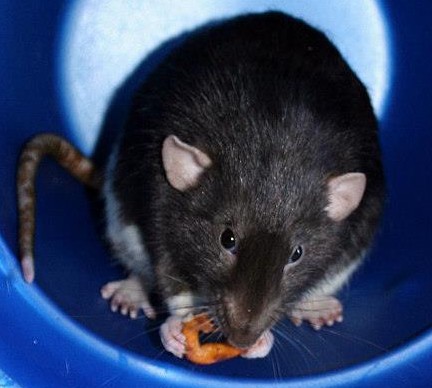 A little over a year ago, I wrote about many of the characteristics of the domestic rat that made them an unexpectedly good choice for a family pet. Since I wrote that blog, my family has welcomed three very personable rats into our home.
A little over a year ago, I wrote about many of the characteristics of the domestic rat that made them an unexpectedly good choice for a family pet. Since I wrote that blog, my family has welcomed three very personable rats into our home.
To my family, rats are funny, playful, treat-stealing companions. However, in other areas of the world, some distant cousins to our mischievous threesome have become real-world heroes. These rats help clear fields of landmines and, as if that were not heroic enough, significantly increase the number of diagnosed tuberculosis infections.
Landmines Kill or Maim Between 1,000 to 2,000 People Every Month (1)
In the late 1990s, a man named Bart Weetjens decided that there needed to be a more economical and efficient method to demine worn-torn areas of Africa. As he researched possible solutions, he came across a research paper from the 1970s that described the ability of gerbils to detect the scent of explosives. Mr Weetjens, who owned pet rats as a boy, wondered if rats could be trained to smell out explosives. He didn’t focus on any rat though; he wanted to use rats already indigenous to the area, the Giant African Pouched Rat (Cricetomys gambianus). Aside from their incredibly sensitive sense of smell, there are several other reasons that rats were such a good candidates for demining activities. Rats are intelligent and easy to train, they are too light to detonate buried explosives by walking over them, and they are relatively inexpensive to breed, house and feed. In addition, they do not bond strongly to their trainers, so they can be used by multiple handlers and their small size makes them easy to transport.
In 1998, the organization that Mr. Weetjens founded, the Anti-Persoonsmijnen Ontmijnende Product Ontwikkeling (APOPO; Anti-Personnel Landmine Detection Product Development) opened its first research facility focusing on using the Giant African Pouched Rat as mine detection devises. Six years later, the first 11 Mine Detection Rats passed the International Mine Action Standards (IMAS) official licensing tests and the Institute for Demining in Mozambique (IND) granted the Mine Detection Rats operational accreditation.
The mine detection rats have an accuracy rate of 95-100% (2) and can clear a field that would take traditional metal detecting methods two days in only 45 minutes. APOPO has never lost a rat as a result of an explosive device detonating.
A hero’s a hero no matter how long his tail.
This video shows a typical morning of training for a mine detection rat:
Tuberculosis is Second Only to HIV/AIDS as the Greatest Killer Worldwide Due to a Single Infectious Agent (3)
Tuberculosis (TB) is caused by the bacteria Mycobacterium tuberculosis. TB infection most often affects the lungs and is spread from person to person through the air when a person with TB coughs, sneezes or spits. It only takes the inhalation of a few of these air-born particles to infect someone. In 2011, 8.7 million people contracted tuberculosis, and 1.4 million people died from tuberculosis disease (3). If diagnosed, TB is curable; however, over 95% of TB deaths occur in low- and middle-income countries where access to diagnostic testing is limited. The most common diagnostic method used in these countries is smear microscopy. Although it is simple and low tech enough to be used in very rudimentary facilities, smear microscopy is labor intensive and not very sensitive.
APOPO first began training Giant African Pouched rats to detect TB in 2003. Their results to date are impressive. When used in conjunction with smear microscopy, the TB detection rats increase new case detection by 46.8%. When the results were compared to culture/multiplex PCR analysis, smear microscopy identified 58% of positive patients, whereas the detection rat correctly identified 70.5% of positive patients (4). In addition to being more sensitive, one rat can screen more samples in ten minutes than a technician can screen in one day.
To see a TB detection rat in training, watch the video here:
Do these rats deserve the title “Hero”? I think the numbers speak for themselves.
Landmines
Mozambique
6,423, 361 m2 Land returned to population
2,406 Landmines found and neutralized
13,025 small arms and ammunitions found
992 bombs found and destroyed
Thailand
79,419,210 m2 Total area covered
588 Landmines found and neutralized
939 UXO found and destroyed
Tanzania training center
64 Mine Detection Rats accredited in 2012
Tuberculosis
Dar es Salaam
16 Collaborating TB clinics
146,601 Sputum samples screened since 2007
2,899 Additional TB patients identified by rats
Morogoro research center
54 Accredited TB rats trained
References
- International Commitee of the Red Cross www.icrc.org/eng/resources/documents/misc/57jmcy.htm
- Mahoney, A., et al. (2012). Mine Detection Rats: Effects of Repeated Extinction on Detection Rates. The Journal of ERW and Mine Action, issue 16.3, Fall 2012.
- World Health Organization Fact Sheet N*104 : Tuberculosis.
- Mahoney, A. et al. (2012) Pouched Rats’ Detection of Tuberculosis in Human Sputum: Comparison to Culturing and Polymerase Chain Reaction. Tuberculosis Research and Treatment, vol. 2012, Article ID 716989, 5 pages. doi:10.1155/2012/716989.
